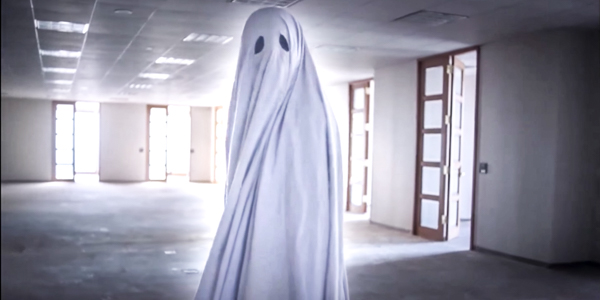There are few Halloween costumes as unabashedly silly as a bedsheet with two holes cut out of it. That last minute ghost outfit stretches back to mid-19th-century Irish celebrations of Halloween, but today looks like an embarrassingly sweet nod to Charlie Brown.
So when writer-director David Lowery’s new film A Ghost Story made a bedsheet ghost its central image, it looked like either an unfunny parody of ghost stories or the worst scary movie ever made.
Thankfully, it’s neither. There are moments of both levity and eeriness in A Ghost Story, but Lowery’s unconventional meditation on mortality is a different kind of scary.
The film opens on a young couple, played by a shaggy Casey Affleck and a pallid Rooney Mara, adjusting to a plain-looking one-story home in rural Texas. The pair previously appeared together in Lowery’s Ain’t Them Bodies Saints, a respectable 2013 film about an outlaw reconnecting with his family after escaping from prison. But in A Ghost Story, Affleck and Mara play ordinary people with ordinary problems. The characters don’t have names; “C” is a distracted musician, locked away in his headphones and insistent that this house become their home; “M” is gentle and supportive but completely unsettled. Long shots of the two speaking and caressing capture a relationship cultivated through years of quiet intimacy, and set a downtempo pace that relishes stillness and silence.
But this is no ordinary story. Lowery slowly draws us into a kind of time warp, opting for a 4:3 aspect ratio with rounded corners to give the film a nostalgic, bittersweet feel. That mood is only underscored by composer Daniel Hart’s “I Get Overwhelmed” (written for his band Dark Rooms), which stretches through the story and becomes a kind of theme song for the characters. Light dances on their walls; things go bump in the night; and a kind of eerie quality fills this house, as if something awful is about to happen.
It does – C dies in a tragic accident – but after a long, disquieting shot of his body lying motionless, he rises and wanders out of the hospital, two black eyes looking blankly ahead and his white sheet flowing behind.
The tension of wanting to laugh is there right away, and never really goes away, especially when the ghost eventually finds and “talks” to another ghost. But Lowery has the ghost glide with a delicacy and silent mystery that begins to feel otherworldly. He arrives at home – for what, he doesn’t seem to know, and neither do we – but lingering shots capture C’s state between time and eternity. (In a much talked about scene, a grief-stricken Mara consumes almost an entire pie in a single sitting in two long shots, and all we can do is watch with the ghost in helpless silence.) When M leaves behind a folded note in the house, the ghost struggles patiently to get it out from the wall. As tenants move in and out of the house and the days slip into years, the ghost’s frustration and confusion mount and physically manifest – and a short movie takes a turn into a kind of short story about time itself.
Its literary influences are on its sleeve – an epigraph from Virginia Woolf (“Whatever hour you woke there was a door shutting”), copies of Hemingway and Nietzsche in the home – and in one scene, a “Prognosticator” in overalls (played by Will Oldham) downs beers with friends at a house party, talking about Beethoven’s symphonies, the eclipse of God, and the heat death of the universe. All things will pass away, he argues, so nothing anyone does is ultimately of any significance. The ghost’s journey seems to be clear evidence to the contrary – his soul lives on, even in death – but then, what’s the significance of this afterlife?
At a screening of the film hosted by the Tibet House, moviegoers pressed Lowery on the whether the film mirrors the concept of Bardo from Tibetan Buddhism, an intermediate state of clarity between different incarnations. “I’m not specifically spiritual in any one way,” he said. “I was raised in a very Catholic household and that fell away in my teens and twenties. It stopped mattering to me. That continues to be true, and other faiths have not replaced it. I’ve sort of just become, for lack of a better term, agnostic.”
Lowery acknowledged that there are aspects of Buddhism that fit in with the movie. A Ghost Story could also be read as reflecting his Catholic roots through a Purgatory-like condition of purification after death. The film itself remains agnostic, but commendably steers the genre back toward its searching metaphysical roots, and the word “ghost” to its etymological origin of “spirit.”
So what becomes of C’s spirit? What was it about this house that so marked his soul? What was he looking for there? The answers seem to have something to do with conquering the quagmire of the self with a selfless love stronger than decay – but the experience itself is enough to have you wondering about it all long after you wander out of theater.

